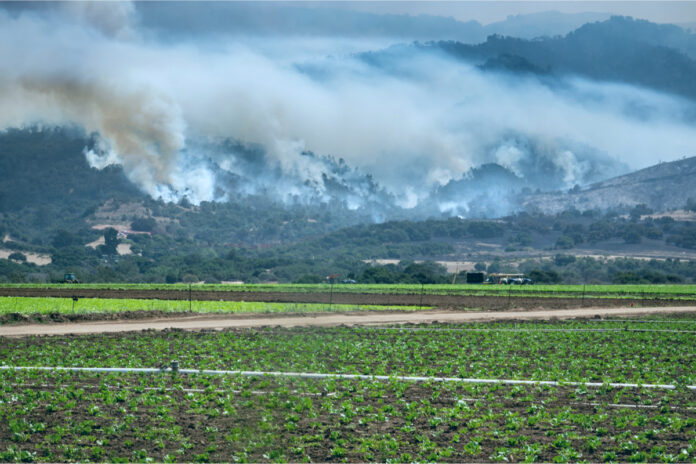
UNITED STATES – Crops are particularly affected by changes in climate and 2020 has proved formidable for farmers in California, Colorado, Oregon, and Washington State—especially those with hemp or cannabis crops. So far, more than five million acres have burned in massive wildfires throughout the western states.
While fires have blazed since late summer, it has been unclear whether legal cannabis businesses would be eligible for federal emergency wildfire disaster relief. Since cannabis still is categorized as a federally-prohibited substance, state-legal cannabis industry businesses have had few, if any, options for emergency relief during back-to-back unprecedented crises.
Hemp farmers recently were included in federal pandemic relief through the U.S. Department of Agriculture’s Farm Service Agency’s Coronavirus Food Assistance Program (CFAP2), which distributes federal emergency aid to crop farmers.
U.S. Senators Ron Wyden and Jeff Merkley, and U.S. House Representatives Earl Blumenauer and Peter DeFazio—all Democrats from Oregon—on Thursday, introduced legislation that would ensure state-legal cannabis businesses would qualify for disaster recovery programs like any other business.
The Small Business Disaster Relief Equity Act would “prevent federal agencies from denying disaster relief to state-legal cannabis businesses, solely because of cannabis-related activities.”
“Whether you’re for or against state-legal cannabis, we can all agree that families in all of our communities are struggling to keep the lights on and stay afloat during this turbulent time—and that they need and deserve support,” said Senator Merkley. “That includes thousands of small business owners, workers, and their families who rely on state-legal cannabis businesses for their livelihoods. We have to make sure those families won’t be shut out from critical assistance that can make a real difference.”
Oregon
Oregon has been particularly hard hit by fires—from its southern border, north to the Washington State border—so it’s no surprise state lawmakers have sponsored legislation to provide relief for the cannabis and hemp industries.
As of September 28, one million acres had burned in 468 wildfires in Oregon, with nearly 2,300 residences destroyed, as well as an additional 1,503 structures. There have been nine fatalities and nine others are still missing.
“It’s ridiculous that legal businesses here in Oregon are being denied critical wildfire aid because of outdated policies handed down from Washington, D.C.,” Representative DeFazio said. “Cannabis businesses employ thousands across Oregon and are a vital economic engine for our state. This important legislation will ensure that these businesses are eligible for the same aid as every other business impacted by the 2020 wildfires.”
Colorado
The Pine Gulch Fire became the largest fire in Colorado’s history. Ignited July 31 by a lightning strike near the town of Grand Junction, Colorado, the fire eventually burned more than 139,000 acres and was 100 percent contained as of five days ago.
“During the night of August 18, the fire grew quickly due to thunderstorm winds up to forty [miles per hour] for a three to four hour period. As a result, the fire increased by more than 30,000 acres that night,” a Bureau of Land Management summary of the fire read.
The Grizzly Creek Fire, which in August started east of the Pine Gulch blaze, also added to smoky conditions effecting thousands of residents and two of Colorado’s important crops: cannabis and wine grapes.
Founder of Colorado’s Yeti Farms, Shawn Honaker told WineMag.com that this is his second go-round with a major wildfire. He said because Yeti produces cannabis extracts, ash from the first wildfire (in 2017) did not adversely affect product quality. Smoke, however, is a big concern. Not only does it block ultraviolet rays from reaching growing crops, it also can be hazardous for crop workers who during harvest would be working outside, especially if those workers have respiratory medical conditions.
There is little research on how smoke and ash from wildfires may affect cannabis or hemp crops. In Colorado, winemakers and vineyards have tapped researchers from the University of Colorado to gauge the damage done to this year’s crop of wine grapes.
Like cannabis, wine grapes are harvested between September and October, which this year means farmers will be anxiously weighing the worth of crops if they have been tainted by smoke.
According to experts, grapes are most susceptible near harvest; while ash can be washed off, phenol compounds in the smoke bind to the grapes’ skins. With red wines, skins are left on during the wine making process—so, the fires could greatly affect 2020 domestic reds.
Smoky, ashen skies also can stunt the growth of cannabis plants. Ash that coats the leaves of plants can be washed off, but it is harder to predict if toxic compounds contained in ash and smoke will leach into plants and taint harvested crops. Some growers in affected areas are harvesting early, to avoid more exposure to smoke and ash.
California
In Northern California—home to multiple regions where the soil is legendarily lush and fertile for marijuana and grape cultivation—wildfires have been ablaze since mid-August when the state’s largest fire on record was ignited. The August Complex Fire has since scorched more than 471,000 acres. It was started when thirty-eight smaller fires caused by lightening strikes joined into one firestorm across Glenn, Lake, Mendocino, Tehama, and Trinity Counties, north of Sacramento.
In the legendary Emerald Triangle and areas further north, cannabis growers are facing the second or third year in a row of historic wildfires.
The August Complex Fire is the biggest of three fires that set records in California this year; including the SCU Lightning Complex Fire that has burned more than 360,000 acres in Santa Clara, Alameda, Contra Costa, San Joaquin, Merced, and Stanislaus Counties, and is still active; and the LNU Lightning Complex Fire, which is 98 percent contained and has burned more than 360,000 acres in Napa, Sonoma, and Solano counties.
Just since September 27, two more fires have erupted: the Glass Fire, which currently is burning in Napa County, and the Zogg Fire in Shasta County. The Glass Fire has already engulfed at least three local landmarks in Napa’s wine country.
Trinity County Sheriff’s Department Deputy Nate Trujillo told news agency Associated Press last week that so close to harvest, many legal and illegal growers are refusing to leave behind crops, even in areas that are under evacuation orders. Some fear looting, if they are forced to evacuate.
Trujillo said the county has only forty legal cannabis businesses but hundreds of illegal farms, and that plants at this time of year would be up to sixteen feet tall and in the final stages before harvest.
Reportedly, federal and local officials in Trinity County have warned rural residents that in the event of extreme fire danger, if they refuse to evacuate, local first responders will not risk their lives in order to rescue those individuals who ignore evacuation orders.
An early fall heat wave is expected to affect most of the west coast this week, lasting until Friday, which also may bring high winds. Temperatures in the San Francisco Bay Area yesterday were reported to be in mid-90s.











